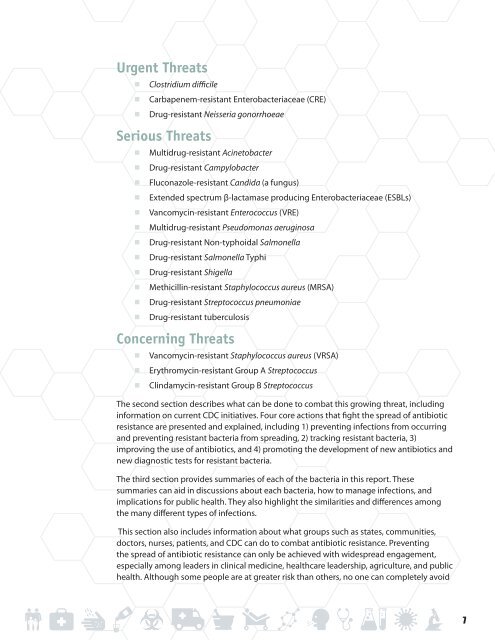Antibiotic Resistance Threats in the United States, 2013 report
Antibiotic Resistance Threats in the United States, 2013 report
Antibiotic Resistance Threats in the United States, 2013 report
Create successful ePaper yourself
Turn your PDF publications into a flip-book with our unique Google optimized e-Paper software.
Urgent <strong>Threats</strong><br />
■■<br />
■■<br />
■■<br />
Clostridium difficile<br />
Carbapenem-resistant Enterobacteriaceae (CRE)<br />
Drug-resistant Neisseria gonorrhoeae<br />
Serious <strong>Threats</strong><br />
■■<br />
■■<br />
■■<br />
■■<br />
■■<br />
■■<br />
■■<br />
■■<br />
■■<br />
■■<br />
■■<br />
■■<br />
Multidrug-resistant Ac<strong>in</strong>etobacter<br />
Drug-resistant Campylobacter<br />
Fluconazole-resistant Candida (a fungus)<br />
Extended spectrum β-lactamase produc<strong>in</strong>g Enterobacteriaceae (ESBLs)<br />
Vancomyc<strong>in</strong>-resistant Enterococcus (VRE)<br />
Multidrug-resistant Pseudomonas aerug<strong>in</strong>osa<br />
Drug-resistant Non-typhoidal Salmonella<br />
Drug-resistant Salmonella Typhi<br />
Drug-resistant Shigella<br />
Methicill<strong>in</strong>-resistant Staphylococcus aureus (MRSA)<br />
Drug-resistant Streptococcus pneumoniae<br />
Drug-resistant tuberculosis<br />
Concern<strong>in</strong>g <strong>Threats</strong><br />
■■<br />
■■<br />
■■<br />
Vancomyc<strong>in</strong>-resistant Staphylococcus aureus (VRSA)<br />
Erythromyc<strong>in</strong>-resistant Group A Streptococcus<br />
Cl<strong>in</strong>damyc<strong>in</strong>-resistant Group B Streptococcus<br />
The second section describes what can be done to combat this grow<strong>in</strong>g threat, <strong>in</strong>clud<strong>in</strong>g<br />
<strong>in</strong>formation on current CDC <strong>in</strong>itiatives. Four core actions that fight <strong>the</strong> spread of antibiotic<br />
resistance are presented and expla<strong>in</strong>ed, <strong>in</strong>clud<strong>in</strong>g 1) prevent<strong>in</strong>g <strong>in</strong>fections from occurr<strong>in</strong>g<br />
and prevent<strong>in</strong>g resistant bacteria from spread<strong>in</strong>g, 2) track<strong>in</strong>g resistant bacteria, 3)<br />
improv<strong>in</strong>g <strong>the</strong> use of antibiotics, and 4) promot<strong>in</strong>g <strong>the</strong> development of new antibiotics and<br />
new diagnostic tests for resistant bacteria.<br />
The third section provides summaries of each of <strong>the</strong> bacteria <strong>in</strong> this <strong>report</strong>. These<br />
summaries can aid <strong>in</strong> discussions about each bacteria, how to manage <strong>in</strong>fections, and<br />
implications for public health. They also highlight <strong>the</strong> similarities and differences among<br />
<strong>the</strong> many different types of <strong>in</strong>fections.<br />
This section also <strong>in</strong>cludes <strong>in</strong>formation about what groups such as states, communities,<br />
doctors, nurses, patients, and CDC can do to combat antibiotic resistance. Prevent<strong>in</strong>g<br />
<strong>the</strong> spread of antibiotic resistance can only be achieved with widespread engagement,<br />
especially among leaders <strong>in</strong> cl<strong>in</strong>ical medic<strong>in</strong>e, healthcare leadership, agriculture, and public<br />
health. Although some people are at greater risk than o<strong>the</strong>rs, no one can completely avoid<br />
7
















